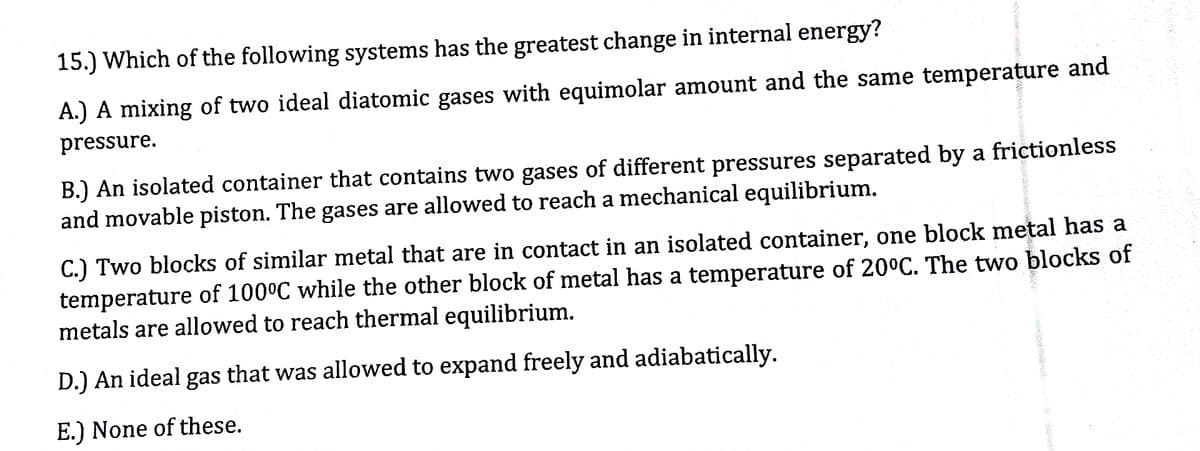15.) Which of the following systems has the greatest change in internal energy? A.) A mixing of two ideal diatomic gases with equimolar amount and the same temperature and pressure. B.) An isolated container that contains two gases of different pressures separated by a frictionless and movable piston. The gases are allowed to reach a mechanical equilibrium. C.) Two blocks of similar metal that are in contact in an isolated container, one block metal has a temperature of 100°C while the other block of metal has a temperature of 20°C. The two blocks of metals are allowed to reach thermal equilibrium. D.) An ideal gas that was allowed to expand freely and adiabatically. E.) None of these.
15.) Which of the following systems has the greatest change in internal energy? A.) A mixing of two ideal diatomic gases with equimolar amount and the same temperature and pressure. B.) An isolated container that contains two gases of different pressures separated by a frictionless and movable piston. The gases are allowed to reach a mechanical equilibrium. C.) Two blocks of similar metal that are in contact in an isolated container, one block metal has a temperature of 100°C while the other block of metal has a temperature of 20°C. The two blocks of metals are allowed to reach thermal equilibrium. D.) An ideal gas that was allowed to expand freely and adiabatically. E.) None of these.
Physical Chemistry
2nd Edition
ISBN:9781133958437
Author:Ball, David W. (david Warren), BAER, Tomas
Publisher:Ball, David W. (david Warren), BAER, Tomas
Chapter2: The First Law Of Thermodynamics
Section: Chapter Questions
Problem 2.66E: In orbit about Earth, a weather balloonjettisons a weight andascends to a higher altitude. If the...
Related questions
Question

Transcribed Image Text:15.) Which of the following systems has the greatest change in internal energy?
A.) A mixing of two ideal diatomic gases with equimolar amount and the same temperature and
pressure.
B.) An isolated container that contains two gases of different pressures separated by a frictionless
and movable piston. The gases are allowed to reach a mechanical equilibrium.
C.) Two blocks of similar metal that are in contact in an isolated container, one block metal has a
temperature of 100°C while the other block of metal has a temperature of 20°C. The two blocks of
metals are allowed to reach thermal equilibrium.
D.) An ideal gas that was allowed to expand freely and adiabatically.
E.) None of these.
Expert Solution
This question has been solved!
Explore an expertly crafted, step-by-step solution for a thorough understanding of key concepts.
Step by step
Solved in 4 steps

Knowledge Booster
Learn more about
Need a deep-dive on the concept behind this application? Look no further. Learn more about this topic, chemistry and related others by exploring similar questions and additional content below.Recommended textbooks for you

Physical Chemistry
Chemistry
ISBN:
9781133958437
Author:
Ball, David W. (david Warren), BAER, Tomas
Publisher:
Wadsworth Cengage Learning,

Principles of Modern Chemistry
Chemistry
ISBN:
9781305079113
Author:
David W. Oxtoby, H. Pat Gillis, Laurie J. Butler
Publisher:
Cengage Learning

Chemistry: Principles and Practice
Chemistry
ISBN:
9780534420123
Author:
Daniel L. Reger, Scott R. Goode, David W. Ball, Edward Mercer
Publisher:
Cengage Learning

Physical Chemistry
Chemistry
ISBN:
9781133958437
Author:
Ball, David W. (david Warren), BAER, Tomas
Publisher:
Wadsworth Cengage Learning,

Principles of Modern Chemistry
Chemistry
ISBN:
9781305079113
Author:
David W. Oxtoby, H. Pat Gillis, Laurie J. Butler
Publisher:
Cengage Learning

Chemistry: Principles and Practice
Chemistry
ISBN:
9780534420123
Author:
Daniel L. Reger, Scott R. Goode, David W. Ball, Edward Mercer
Publisher:
Cengage Learning

Chemistry: Principles and Reactions
Chemistry
ISBN:
9781305079373
Author:
William L. Masterton, Cecile N. Hurley
Publisher:
Cengage Learning

Chemistry
Chemistry
ISBN:
9781305957404
Author:
Steven S. Zumdahl, Susan A. Zumdahl, Donald J. DeCoste
Publisher:
Cengage Learning
